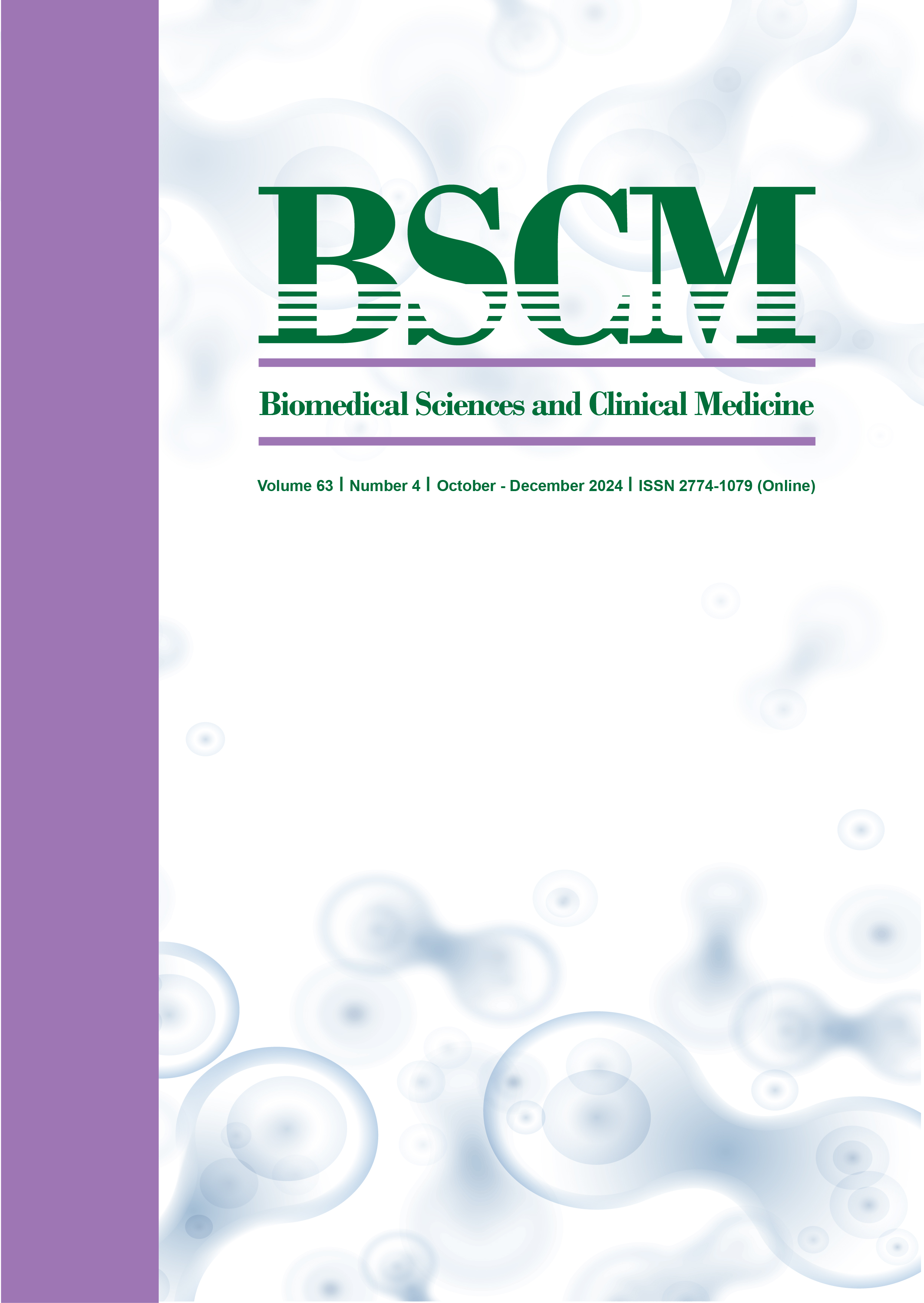Effect of Adding Dexmedetomidine to 0.5% Bupivacaine on Scalp Block on Intraoperative Hemodynamics During the First Hour of Surgery and Anesthetic Requirement in Intracranial Surgery
Main Article Content
Abstract
Objective Dexmedetomidine has been used as a perineural local anesthetic (LA) adjunct to improve the quality of block and decrease opioid consumption. This study aims to determine the efficacy of adding dexmedetomidine to 0.5%bupivacaine on scalp block on hemodynamic responses during the first hour of surgery, intraoperative propofol and fentanyl doses, and analgesic requirements in the first 24 hours post-craniotomy.
Methods A prospective randomized controlled trial was conducted in forty-seven elective craniotomy patients receiving a scalp block with either 1 mcg/kg of dexmedetomidine (group D) or normal saline (group C) added to 0.5% bupivacaine (20 mL in total). Intraoperative blood pressure and heart rate at baseline and at 22 other time points during the first hour following the skin incision as well as the amount of intraoperative propofol and fentanyl and postoperative tramadol doses during the first 24 hours were collected and analyzed. The student t-test was used to compare means between groups, while repeated measure ANOVA with Bonferroni correction was used for comparing repeated means within each group. P-value less than 0.05 was considered statistically significant.
Results During skull pin fixation (T4), the mean arterial pressure (MAP) and heart rate (HR) of both groups increased from baseline, but there were no statistically significant differences between groups. During the first hour of the operation (T7–T22), both groups had lower MAPs than their baselines, and group D had lower MAPs than group C at all time points. Intraoperative doses of fentanyl (mcg/kg) and propofol (mg/kg) in group D were significantly lower than those in group C, p = 0.027 and p = 0.030, respectively.
Conclusions The addition of 1 mcg/kg dexmedetomidine tends to enhance the efficacy of scalp block with 0.5%bupivacaine in attenuating intraoperative hemodynamic responses during the first hour of surgery and reducing intraoperative fentanyl and propofol requirements during intracranial surgery.
Article Details

This work is licensed under a Creative Commons Attribution 4.0 International License.
References
Samuels SI. Anesthesia for supratentorial tumor. In: Cottrell JE, Turndorf H, editors. Anesthesia and neurosurgery. St. Louis: CV Mosby; 1986. p. 114-30.
Owens WB. Blood pressure control in acute cerebrovascular disease. J Clin Hypertens. 2011;13:205-11.
Geze S, Yilmaz AA, Tuzuner F. The effect of scalp block and local infiltration on the haemodynamic and stress response to skull-pin placement for craniotomy. Euro J Anaesthesiol. 2011;26:298-303.
Can BO, Bilgin H. Effects of scalp block with bupivacaine versus levobupivacaine on haemodynamic response to head pinning and comparative efficacies in postoperative analgesia: A randomized controlled trial. J Int Med Res. 2017;45:439-50.
Akhigbe T, Zolnourian A. Use of regional scalp block for pain management after craniotomy: Review of literature and critical appraisal of evidence. J Clin Neurosci. 2017;45:44-7.
Kondavagilu SR, Pujari VS, Chadalawada MV, Bevinguddaiah Y. Low dose dexmedetomidine attenuates hemodynamic response to skull pin holder application. Anesth Essays Res. 2017;11:57-61.
Thongrong C, Sirikannarat P, Kasemsiri P, Duangthongphon P. Comparison of dexmedetomidine and fentanyl to prevent haemodynamic response to skull pin application in neurosurgery: double blind randomized controlled trial. Anaesthesiol Intens Ther. 2017;49:268-73.
Peng K, Wu S, Liu H, Ji F. Dexmedetomidine as an anesthetic adjuvant for intracranial procedures: Meta-analysis of randomized controlled trials. J Clin Neurosci. 2014;21:1951-8.
Vorobeichik L, Brull R, Abdallah FW. Evidence basis for using perineural dexmedetomidine to enhance the quality of brachial plexus nerve blocks: A systematic review and meta-analysis of randomized controlled trials. Br J Anaesth. 2017;118:167-81.
Pinosky ML, Fishman RL, Reeves ST, Harvey SC, Patel S, Palesch Y, et al. The effect of bupivacaine skull block on the hemodynamic response to craniotomy. Anesth Analg. 1996;83:1256-61.
Kiran Kumar A, Rahmathullah M, Kulkarni DK, Ramachandran G. Efficacy of adding dexmedetomidine to bupivacaine on attenuating hemodynamic response to skull pin placement for performing scalp block. Int J Contemp Med Res. 2017;4:9-13.
Lee EJ, Lee MY, Shyr MH, Cheng JT, Toung TJK, Mirski MA, et al. Adjuvant bupivacaine scalp block facilitates stabilization of hemodynamics in patients undergoing craniotomy with general anesthesia: a preliminary report. J Clin Anesth. 2006;18:490-4.
Kumari S, Shah F. A comparative study of hemodynamic response to incision / pinning with scalp block versus propofol Infusion In neurosurgical procedures. Eur J Mol Clin Med. 2020;7:8197-204.
Kaur M, Singh P. Current role of dexmedetomidine in clinical anesthesia and intensive care. Anesth Essays Res. 2011;5:128-33.
Sahana BN, Radhapuram SD, Samantaray A, Hamanth N, Pasupuleti H, Mangu HR. Comparison of effects of dexmedetomidine added to ropivacaine versus ropivacaine alone infiltration scalp block for attenuation of the haemodynamic response to skull pin placement in neurosurgical procedures: A double-blind, randomised clinical trial. Indian J Anaesth. 2021;65:782-8.
Ikandra H, Benard A, Ruel-Raymond J, Cochard G, Manaud B. The analgesic effect of interscalene block using clonidine as an analgesic for shoulder arthroscopy. Anesth Analg. 2003;96:260-2.
Rao S, Rajan N. Dexmedetomidine as an adjunct for regional anesthetic nerve blocks. Curr Pain Headach Rep. 2021;25:1-7.
Vallapu S, Panda NB, Samangh N, Bharti N. Efficacy of dexmedetomidine as an adjuvant to local anesthetic agent in scalp block and scalp infiltration to control postcraniotomy pain: A double-blind randomized trial. J Neurosci Rural Pract. 2018;9:73-9.
El-aziz MABD, Sc M, Ibrahim N, Mekawey N. The effect of adding dexmedetomidine to levobupivacaine in scalp nerves block on duration of analgesia postoperatively in supratentorial craniotomy operations. Med J Cairo Univ. 2017;85:637-41.
Lekprasert V, Tangjitbampenbun A, Kittiponghansa A, Boongird A, Buachai R, Ittichaikulthol W. Comparison of analgesic effect of levobupivacaine with dexmedetomidine and levobupivacaine for scalp block before supratentorial craniotomy: A randomized controlled trial. J Med Assoc Thai. 2020;103:1028-35.


